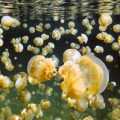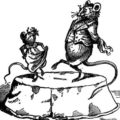
Against incredible odds, researchers working in separate sites, thousands of miles apart in Antarctica have found what they believe are the fossilized remains of two species of dinosaurs previously unknown to science. One of the two finds, which were made less than a week apart, is an early carnivore that would have lived many millions of years after the other, a plant-eating beast, roamed the Earth. One was found at the sea bottom, the other on a mountaintop.
Working on James Ross Island off the coast of the Antarctic Peninsula, veteran dinosaur hunters Judd Case, James Martin and their research team believe they have found the fossilized bones of an entirely new species of carnivorous dinosaur related to the enormous meat-eating tyrannosaurs and the equally voracious, but smaller and swifter, velociraptors that terrified movie-goers in the film “Jurassic Park.”
Features of the animal’s bones and teeth led the researchers to surmise the animal may represent a population of carnivores that survived in the Antarctic long after they had been succeeded by other predators elsewhere on the globe.
“One of the surprising things is that animals with these more primitive characteristics generally haven’t survived as long elsewhere as they have in Antarctica,” said Case, dean of science and a professor of biology at Saint Mary’s College of California who discovered the bones. “But, for whatever reason, they were still hanging out on the Antarctic continent.”
The remains include fragments of an upper jaw with teeth, isolated individual teeth and most of the bones from the animal’s lower legs and feet. The creature likely inhabited the area millions of years ago when the climate and terrain were similar to conditions in today’s Pacific Northwest and radically different than they are today.
Martin, curator of vertebrate paleontology at the South Dakota School of Mines & Technology, said the size and shape of the ends of the lower-leg and foot bones indicate that in life the animal was a running dinosaur roughly 1.8 to 2.4 meters (6 to 8 feet) tall.
The excavations were supported by the National Science Foundation (NSF), the independent federal agency that supports fundamental research and education across all fields of science and engineering. NSF manages the U.S. Antarctic Program, which coordinates almost all U.S. research on the southernmost continent and in the surrounding oceans.
The field party included representatives of Argentina’s Museo de La Plata, Minot State University, the University of Oklahoma, the South Dakota Geological Survey and graduate students from University of California, Riverside and the South Dakota School of Mines & Technology.
According to Case, luck played a major role in the find.
First, relatively few dinosaur fossils from the end of the Cretaceous Period, which lasted from 144 million to 65 million years ago, (the second half of the so-called “Age of Dinosaurs”), have been found in Antarctica. Second, the specimen was an exceedingly rare find and one of only six dinosaur fossils that have been discovered in the James Ross region of the Antarctic Peninsula, the landmass that juts north from the southernmost continent towards South America. Also, to have been preserved at all, the animal likely floated from the shore out to sea after it died roughly 70 million years ago and settled to the bottom of what was then a very shallow area of the Weddell Sea.
The team concentrated its investigations on the Naze, a northerly projecting peninsula, where exposed materials represent a period at the end of the Mesozoic Era, a span of time between 248 million to 65 million years ago that includes the Cretaceous Period. At that time, the area was covered by the waters of the continental shelf, roughly 100 to 200 meters (300 to 650 feet) deep.
If confirmed as Case and Martin expect, the new species is only the second Antarctic theropod from the late Cretaceous Period.
At the same time, thousands of miles away, a research team led by William Hammer of Augustana College in Rock Island, Ill., was working in the Antarctic interior on a mountaintop roughly 3,900 meters (13,000 feet) high and near the Beardmore Glacier. They found embedded in solid rock what they believe to be the pelvis of a primitive sauropod, a four-legged, plant-eating dinosaur similar to better-known creatures such as brachiosaurus and diplodocus. Now known as Mt. Kirkpatrick, the area was once a soft riverbed before millions of years of tectonic activity elevated it skyward
Also a veteran dino hunter known for his discovery of Cryolophosaurus ellioti in 1991, Hammer had returned to the site of that find to continue his work, which had been halted in part because the Cryolophosaurus excavation had dug far into a cliff face, creating a potentially dangerous overhang. Specialized workers were flown into the research camp at Beardmore Glacier to remove the overhang and make it safer to continue the excavations.
As Hammer and his team waited, Peter Braddock, a mountain safety guide on Hammer’s team, scoured the area, informally looking for fossils.
“I jokingly said to him, ‘Keep your eyes down, look for weird things in the rock’,” Hammer said. “He had marked four or five things he thought were odd, including some fossilized roots. But I realized that one of these things was bone: part of a huge pelvis and illium and much, much bigger than the corresponding bones in Cryolophosaurus.”
Based on field analysis of the bones, Hammer and his fellow researchers believe the pelvis-roughly one meter (three feet) across-is from a primitive sauropod that represents one of the earliest forms of the emerging dinosaur lineage that eventually produced animals more than 30 meters (100 feet) long.
Basing his estimates on the bones excavated at the site, Hammer suggests the new, and as-yet-unnamed creature was between 1.8 and 2.1 meters (six and seven feet) tall and up to nine meters (30 feet) long.
Hammer said that the rocks in which the find was made helped to establish that the creature lived roughly 200 million years ago, millions of years before the creature Case and Martin discovered on the Antarctic Peninsula. Hammer said several lines of evidence point to the conclusion that his and the discovery by Case and Martin represent two new species yielded up by the rocks of the “Harsh Continent.”
“This site is so far removed geographically from any site near its age, it’s clearly a new dinosaur to Antarctica,” Hammer said. “We have so few dinosaur specimens from the whole continent, compared to any other place, that almost anything we find down there is new to science,” Hammer said.


















Comments are closed.